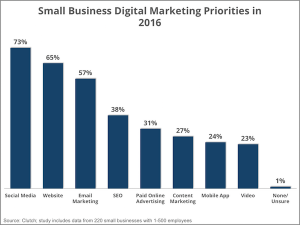
A business may have the best product or service, but if no one knows about it, how long it stays operational is anyone’s guess. Marketing plays a huge role in building brand awareness, and with marketers becoming large IT spenders, it’s not uncommon for CEOs to demand ROI (return on investment) proof.
In a 2011 survey by Ifbyphone, over 80 percent of marketers were expected to measure the effectiveness of their campaigns, but only 29 percent were able to adequately evaluate each channel’s ROI impact.
Then again, as Daniel Kehrer details in a 2013 Forbes article entitled “Why ROI Is Often Wrong for Measuring Marketing Impact,” it may be tricky to use ROI to measure the business impact of your marketing strategies, simply because marketing isn’t really an investment – one-time capital investment, that is – but a recurring expense.
Technicalities aside, justifying marketing spending is a critical exercise for any business. And then, there’s the need to measure the success of your marketing initiatives and understand the various factors impacting customer engagement, and it’s no surprise that analytics software has become a necessary component of any savvy marketer’s technology armory.
Moving beyond a website’s key performance indicators (KPIs)
Analytics in the marketing context isn’t exclusive to what webmasters care about. Marketing analytics goes beyond website performance. It encompasses online and offline marketing performance, the intersection being the sweet spot.
Below are some of the marketing analytics definitions we found on the web:
“Marketing analytics gathers data from across all marketing channels and consolidates it into a common marketing view. From this common view, you can extract analytical results that can provide invaluable assistance in driving your marketing efforts forward.”
“Beyond the obvious sales and lead generation strategies, marketing analytics can offer profound insights into customer preferences and trends.”
Moz:
“Marketing analytics is the measurement and optimization of your marketing activities. Rather than focusing only on your site’s performance like you do with web analytics software, you focus on how your marketing efforts are performing, and adjust them accordingly.”
To further differentiate marketing analytics from web analytics, here are additional articles to peruse:
- Marketing Analytics vs. Web Analytics (Sensible Marketing)
- Why You Need Marketing Analytics, Not Web Analytics (HubSpot)
- Marketing Analytics vs. Web Analytics (Marketing Automation Software Guide)
Web analytics and what metrics to measure
Because online marketing, let alone marketing in general, is a realm too vast to effectively tackle in a single blog post, this article will cover the essential metrics to track when measuring website performance.
Apart from a presence on social media, having a website is no longer negotiable these days. It’s an imperative for a business to reach and communicate with an ever-growing Internet population. But which essential metrics should you track to determine whether a website is delivering as expected or not?
There are a whole bunch of KPIs to watch out for when measuring website success, but we’ll categorize some of the most noteworthy into two essential buckets:
- Page views
- Customer data
Category #1: Page views

Page views directly correlate with the amount of traffic your site receives on a daily basis. While many marketing professionals insist that traffic quality trumps quantity every single time, the fact remains that traffic is an essential metric to track when measuring website success. Without traffic, there’s really not much to go on.
1. Total visits
One of the most important indicators to keep tabs on, total visits can also be tracked for related pages outside of the website, like a landing page for a pay-per-click campaign. Sudden traffic spikes can be attributed to a successful marketing initiative. Dips may be related to a server outage, or a campaign gone wrong.
Paying close attention to your total visits helps ensure your website is always up and running, as well as which marketing channels to investigate in case of an unexpected traffic nosedive.
2. New versus recurring visitors
A breakdown of your total visits to new versus recurring visitors allows you to measure the effect of your audience outreach efforts and the stickiness of your website. Recurring visits tells you if the website is appealing enough for site visitors to visit more than once.
New visits can also indicate if your outbound marketing initiatives are working, such as when you launch a newspaper ad in, say, January to early February for a Valentine’s special.
3. Traffic by channel
Traffic to a site can come from various sources: direct URL, social media, search engine optimization (SEO), or through advertising platforms like Google AdWords, Yahoo! Advertising Network, Microsoft’s adCenter, and so on.
Knowing which of these platforms deliver the best (or worst) returns can point you in the right direction, i.e., redirect your advertising dollars from one platform to another, or ramp up your SEO efforts, if SEO is where your website falls short, for example.
4. Top pages
So what if your About Us page is one of your website’s top 10 most visited pages? Does it make a difference if a blog post you completed in eight hours fares better than one you churned out in less than 30 minutes?
The short answer: Knowing which pages on your site get the most clicks matters.
There are a few things you can do to take advantage of the popularity of certain pages in your website: (1) add an opt-in page, (2) advertise a product or service, (3) link to other pages in the site, or (4) turn it into a landing page.
There’s a reason a certain page, such as a blog post, is hugely popular or linked to repeatedly, and it isn’t always because it took you more hours than usual to complete it. Once you find out what that special reason is, you can use the same formula or technique to boost the performance of other blog posts, whether existing or upcoming.
5. Bounce rate
In web analytics terms, a “bounce” happens when a visitor immediately clicks away from a website without exploring further, which lessens their chances of converting into paying customers.
There are several reasons why a site’s bounce rate skyrockets: (1) the website doesn’t have any information on what the visitor is looking for, (2) the website isn’t easy to navigate, (3) the page on which the visitor landed fully addresses their pressing questions and needs not explore any further, or (4) there are site elements the visitor finds distracting, e.g., background music that auto-plays, obnoxious pop-ups, too many advertising banners, and so on.
Other reasons exist, of course, but in the overall scheme of things, a high bounce rate is neither good nor bad, says Jayson DeMers in a blog post entitled “Bounce Rate: 6 Questions All SEOs Need to Be Able to Answer.” However, keeping it under control by consistently providing valuable content and optimizing the site’s pages, design and layout is good for business in the long run.
6. Exit pages
“Bounce” and “exit” are two terms that aren’t interchangeable. Unlike “bounce,” an “exit” is recorded when the visitor clicks on more than one page and then leaves. Knowing from which pages your visitors leave allows you to take the necessary steps to improve the said page’s performance: (1) check for errors, (2) link internally, (3) add social sharing buttons, or (4) monetize the page through an ad or affiliate link.
7. Conversion rate
Nielsen Norman Group defines conversion rate as the “percentage of users who take a desired action.” A desired action can be any of the following:
- Buying a product from an ecommerce site
- Clicking an internal link
- Signing up for a free trial (in the case of SaaS companies, usually)
- Downloading a discount voucher
- Downloading a PDF or whitepaper in exchange for certain information, such as answers to a survey
- Filling out a contact form
- Signing up for the company’s newsletter
Poor conversion rates can mean: (1) bad website design, (2) website error, (3) inferior product/service offerings, or (4) disinterested visitors. But worst of all, your inability to improve those rates over the short and longer terms can result to the eventual demise of your business, a path reserved for for-profit organizations that don’t make any money.
Understanding your site’s shortcomings and creatively addressing them through continuous A/B testing schemes are the two most important first steps to significantly boost your conversion numbers.
Category #2: Customer data

In online marketing, a first-time visitor converting into a paying customer straightaway isn’t an everyday occurrence. Often, visitors go through a sales cycle – sometimes lengthy ones that can take months, even years – and tying website behavior to an actual customer gives you an insight into essential information that can include:
- How individual visitors respond to your site
- What the visitor wants and why exactly they’re on your site
- How to personalize your interactions with each visitor
- How long it takes to turn a visitor into a customer
- What steps are needed to push “curious” or “interested” visitors further down the sales pipeline
- Which campaigns resonate better with which groups of customers
- What each customer’s lifetime value could be
Final word
Your website is an essential marketing tool, and optimizing your site’s performance to create a customer experience worth writing home about is a commendable goal. Tracking individual visitors’ actual behavior is likewise an avenue worth pursuing. As long as paying customers remain the lifeblood of any business, ensuring their actions correspond to a specific marketing goal is what will keep you in the running for many years to come.
Play with these ideas and tell us what think. Post below and let us know what works for you!
(273)







